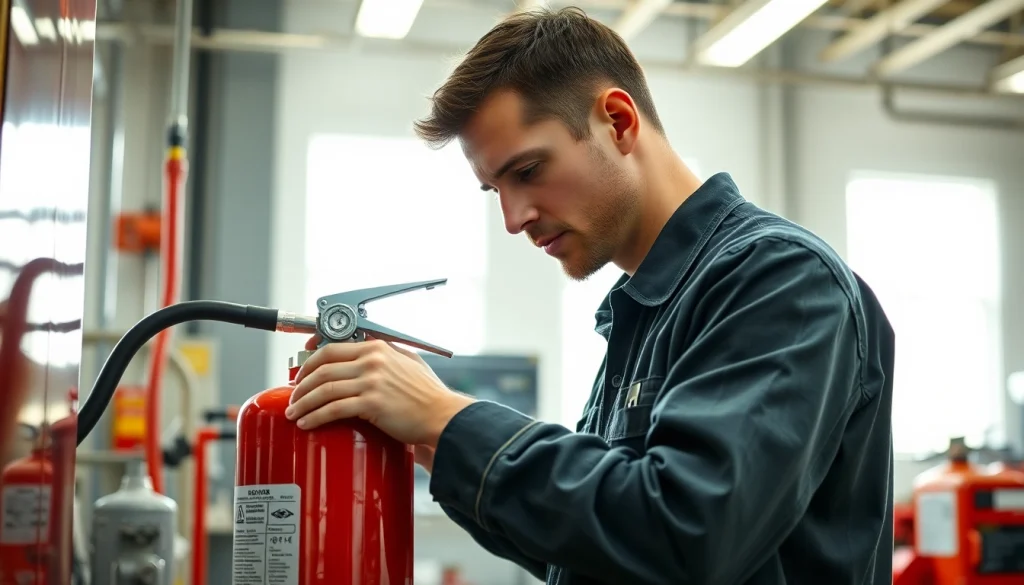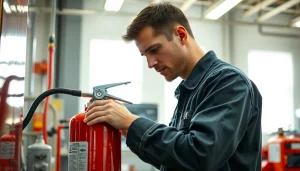Essential Fire Extinguisher Service: Maintenance, Inspections, and Compliance

Understanding Fire Extinguisher Service
Fire safety is a vital aspect of protecting individuals and property from the risks associated with fire outbreaks. One of the cornerstones of effective fire safety is having the right equipment and ensuring it’s well-maintained. This is where fire extinguisher service plays a crucial role. Regular servicing and maintenance of fire extinguishers not only ensure they are in optimal working condition but also help comply with local regulations and standards.
What is Fire Extinguisher Service?
Fire extinguisher service encompasses a series of maintenance procedures designed to keep extinguishers in functional condition. This includes inspections, testing, refilling, and repairs as necessary. Fire extinguishers can be the difference between a minor incident and a full-fledged disaster; thus, their upkeep is paramount. Specific services may vary based on the type of extinguisher and the environment in which it is placed.
Importance of Regular Maintenance
Regular maintenance of fire extinguishers is essential for various reasons:
- Compliance with Regulations: Most jurisdictions require fire extinguishers to be inspected and maintained at regular intervals. Failing to comply can result in fines and legal repercussions.
- Readiness in Emergencies: An unserviced extinguisher may not operate correctly in an emergency situation, leading to worse outcomes.
- Equipment Longevity: Routine maintenance prolongs the life of the extinguisher, making it a better investment over time.
- Safety and Assurance: Regular checks provide peace of mind that safety equipment is operational and reliable.
Common Types of Fire Extinguishers
Understanding the different types of fire extinguishers is crucial for effective service and maintenance:
- Water (Class A): Suitable for ordinary combustibles like wood and paper.
- Foam (Class A and B): Effective against flammable liquids and general combustibles.
- Dry Powder (Class A, B, and C): Versatile extinguishers useful for electrical, flammable liquids, and solid combustibles.
- CO2 (Class B and C): Best for electrical fires and flammable liquids.
- Wet Chemical (Class K): Designed for kitchen fires involving cooking oils and fats.
Key Services Offered in Fire Extinguisher Care
Inspection Protocols
Inspection protocols determine that extinguishers are free from obstructions and are accessible. Key inspection components include:
- Checking pressure gauges to ensure they are in the green zone.
- Looking for physical damage, corrosion, or leaks.
- Ensuring that the inspection tag is up-to-date and filled correctly.
Regular inspections typically occur monthly, while more detailed inspections are required annually.
Refilling and Recharging Procedures
Extinguishers must be refilled or recharged after use and periodically checked for pressure levels. The procedures involve:
- Discharging residual contents safely.
- Cleaning the cylinder and examining it for damages.
- Refilling it with the appropriate agent according to the manufacturer’s specifications.
Annual Safety Checks and Compliance
Annual safety checks ensure that fire extinguishers comply with local and national regulations, such as those outlined by the National Fire Protection Association (NFPA). During these checks, a licensed technician will:
- Perform a thorough inspection of equipment.
- Document the results and make recommendations based on findings.
Choosing the Right Fire Extinguisher Service Provider
Qualifications and Certifications to Look For
When selecting a fire extinguisher service provider, consider their qualifications. Look for certifications from recognized organizations, such as NFPA or the International Code Council (ICC). Providers should also have training in:
- Fire suppression systems
- Emergency preparedness
- Health and safety regulations
Customer Reviews and Testimonials
Analyzing customer reviews and testimonials provides insight into a service provider’s reliability and performance. Review platforms like Yelp can help gauge customer satisfaction levels. In addition, consider asking for direct references from the service provider.
Service Packages and Pricing
Many fire extinguisher service providers offer various service packages tailored to meet specific business needs. Pricing should be transparent and include a breakdown of services offered, such as:
- Inspection and maintenance
- Refilling and recharging
- Emergency services
It’s essential to compare costs while ensuring adequate coverage and adhering to safety standards. Always clarify what services are included in a specific package to avoid hidden costs.
Implementing Fire Extinguisher Protocols in Your Business
Creating a Fire Safety Plan
Formulating a fire safety plan involves identifying potential fire hazards and designing appropriate responses. Essential components include:
- Training employees on fire risks associated with their roles.
- Establishing evacuation routes and procedures.
- Assigning responsibilities for equipment checks and fire drill schedules.
Employee Training for Fire Extinguishers
Training is crucial for ensuring that employees know how to use fire extinguishers correctly. Effective training sessions should cover:
- The types of fire extinguishers available in the workplace.
- How to operate an extinguisher using the PASS method (Pull, Aim, Squeeze, Sweep).
- Identifying when it is safe to fight a fire and when to evacuate.
Regular Review of Fire Safety Procedures
Fire safety procedures should not be static; regular reviews and updates are necessary to address new challenges or changes in the workplace. Changes in operational systems may require new training materials, updated escape routes, or revised safety equipment.
Measuring Effectiveness and Compliance in Fire Safety
Assessing Fire Safety Training Impact
To ensure that training is effective, businesses should measure its impact through tools such as evaluations and feedback forms. Post-training assessments can help identify areas for improvement, ensuring training remains relevant and effective.
Documentation and Record-Keeping
Keeping accurate records of inspections, maintenance, and training is essential. Documentation ensures compliance with regulations and provides a record of safety practices within the organization. Records should include:
- Inspection dates and findings
- Service history for each fire extinguisher
- Training records for employees
Evaluating Service Provider Performance
Regular evaluations of your fire extinguisher service provider are critical for ensuring that they meet the standards and expectations set forth in the service agreement. Consider key performance indicators such as:
- Timeliness of service
- Quality of workmanship
- Customer satisfaction
By implementing comprehensive evaluation criteria, you ensure that you receive the best service possible, fostering a culture of safety throughout your organization.







